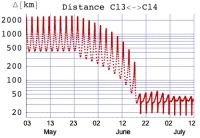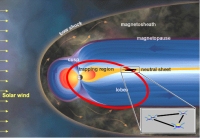Formation Flying at Closest-Ever Separation
21 June 2007
After weeks of manoeuvres in space, Samba and Tango, two of the four Cluster satellites, are now flying in formation with a separation distance as small as 17 kilometres. This is the closest distance two ESA satellites have ever been in routine operations and will enable new scientific discoveries by Cluster, the first space mission to observe the Sun-Earth connection in 3D with four identical spacecraft.Seventeen kilometres sounds like a safe separation distance, but for orbiting spacecraft it is not. First, in the case of the Cluster mission, each satellite has a velocity of roughly 6 kms-1 with respect to the Earth. Second, almost seven years after launch, the batteries on each spacecraft are far beyond their nominal lifetime and battery anomalies can lead to unplanned velocity changes.
 |
|
Image 1. The Cluster Flight Control Team |
Before the current manoeuvre campaign, Samba and Tango were separated by a minimum distance of 450 km, following each other around the Earth in a polar elliptical orbit from roughly 14 000 km up to 124 000 km altitude, every 57 hours. In order to avoid any collision risk, even in case of a major performance error, Samba was first put into its target orbit, close to but non-intersecting the one of Tango, in a sequence of three manoeuvres.
 |
|
Image 2. Evolution of the distance between Samba and Tango Cluster satellites over the past few weeks. |
These manoeuvres also changed the orbit period of Samba to start a drift phase between 25 May and 20 June to reduce the separation distance from Tango (image 2). Finally a small burn on Samba stopped the drift at a separation distance from Tango of 17 km, coincident with the time the spacecraft are closest to the Earth. "The inter spacecraft distance of 17 km is approaching the limit that can be done with Cluster, where the four spacecraft are independent. Future missions will need to embark inter-satellites communication systems to achieve even smaller distances," says Detlef Sieg flight dynamics engineer at ESOC.
However, this distance is not constant along Cluster's orbit and is greater when the spacecraft are farther from the Earth. The separation is up to 40 km when the spacecraft are in the magnetotail located on the night side of the Earth, in a thin layer called the neutral sheet. Investigating the physics of the neutral sheet region is one of the prime objectives of the Cluster mission. A variety of spacecraft separation distances, together with different constellation orientations are necessary to comprehend the complexity of its dynamics and the geophysical phenomena that occur there.
Before the campaign of manoeuvres Samba and Tango were separated by 450 km. Rumba, Salsa and the closer Samba-Tango pair formed an isosceles triangle in space with a size of 10 000 km, however it was oriented roughly perpendicularly to the neutral sheet. At the request of the Cluster scientific community ESA modified this orientation in order to get the triangle roughly parallel to the equator inside the neutral sheet (Image 3). A series of manoeuvres on both Salsa and Rumba were necessary to achieve this target.
"This space ballet is another major achievement of the Cluster flight control team at ESOC. Their contribution is key to the on-going scientific success of the Cluster mission," says Philippe Escoubet, ESA Cluster and Double Star project scientist.


